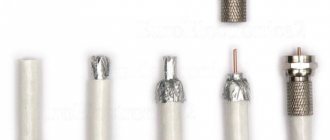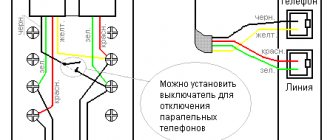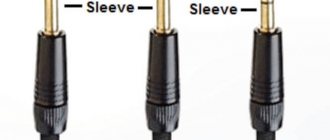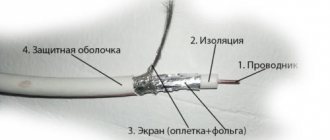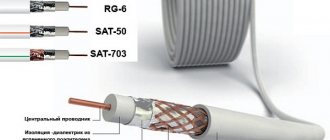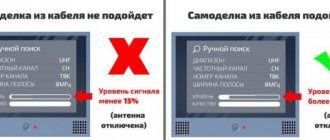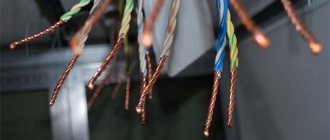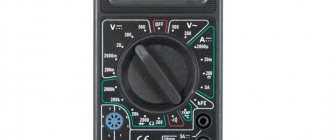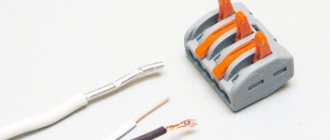Despite the wide possibilities of the Internet, for many people the main means of media and source of entertainment remains television. During the operation of equipment, it often becomes necessary to extend or restore the antenna cable. There are many reasons for such actions: breakage or damage to integrity, aging or wear of the wire, moving an antenna or TV to a new location, installing an additional TV receiver. Buying a new cable of the required length is an unreasonable waste of money, especially since you can get by with minimal costs: replacing the damaged section and connecting the cable or extending the existing wire. But before you begin, it is recommended that you familiarize yourself with the structure of the cable and the methods of its connection.
When to connect the wire
There are three common situations where a coaxial cable connection is needed.
- Complete break or partial damage to the cable antenna line. The wire transmits an ethereal signal, which is very sensitive and can be attenuated by the slightest factors. Therefore, if you see some very vulnerable spot on the line, where the wire is barely holding on, it is better to cut it and connect it again.
- It is necessary to extend the antenna cable for the TV. It often happens when television equipment is moved to another place in the room. Accordingly, the previously laid wire may not be enough. Then you have to lengthen the wire. A second piece is connected to the end of the previous cable to reach its destination.
- Connecting an existing wire to another television receiver. Instead of installing a separate antenna for each TV, you can connect to an already working one. Then a wire is drawn from the new TV, which connects to the line running to the apartment or house.
Preparation and tools
As for the tools, you and I will need ordinary side cutters and a construction knife (instead of a construction knife, a stationery knife can also do). To connect the ends of a television cable, you need special coaxial cable connectors. They are also called F-connectors.
More specifically, we need two FS-5 threaded F connectors and one straight F reducer. They are usually quite inexpensive!
If you need to extend the antenna cable when moving a TV or antenna, you must also buy a cable. To do this, before going to the store, carefully inspect your wire and rewrite the markings, or better yet, cut off a small piece from it and go to the store with it.
Is it possible to connect without losing signal?
Having an attachment point on any sensitive conductor creates losses. But, depending on the connection method, the losses will either be invisible or be felt even with the naked eye when channels are displayed.
If you need to connect an antenna cable without loss of signal, the only correct method is to install two F-connectors at the ends and connect them with a threaded adapter. This is the most reliable way, and you can always disconnect back if necessary.
If we talk about twisting, then this is the worst way to connect a television cable to each other. A high-quality alternative is soldering, which also eliminates the loss of the television signal after connection.
Antenna cable device
Modern antenna cables have some technical differences, different properties and materials used in their manufacture, but they have a common design:
- The main copper or copper-clad steel core, covered with a thick polypropylene sheath.
- The screen, made in the form of aluminum foil or copper mesh, protects the conductor from electromagnetic interference.
- The plastic outer shell prevents exposure to external fields.
- Polyethylene cable covering that protects against mechanical damage.
Each of these elements has its own role, so their integrity is as important as the overall condition of the cable. When connecting two wires, both ends are carefully cut and cleaned.
This process is usually called cutting. It provides a reliable connection on which the signal quality depends.
How to connect: working methods
- Adapter for connecting two F-type connectors to each other (coupling coupling). In common parlance it is called a barrel. The screen is connected through the common metal part of the adapter. And inside there is a groove for connecting the cable core. This is the best way to connect or extend a TV cable.
- Soldering. The second best method of attaching wires. But you need to know how to use a soldering iron. Therefore, you need a soldering iron and solder.
- Twisting. Allows you to return the line to functionality, but is not recommended for use. It is better to use it only as a temporary connection until you buy an adapter.
- Extension cord for television cable. Sold immediately with plugs attached. A female connector is attached to one side to connect it to the male end of the previous wire. If you need to do cable extension, then this is a good option. There is nothing you need to do other than plug in the extension cord. The cost of the cord depends on the length and quality of workmanship (conductor material and insulation).
- Splitter. If in a home television system only one TV operates from the antenna, then installing even the simplest two-channel splitter is not worth it. Yes, the divider contains one antenna signal input and outputs. Therefore, connect one part of the wire that leads from the on-air receiver to the input of the splitter, and connect the second to the output. But the problem is that the splitter not only passes the signal through the connected cable, but also splits it. The division is performed by the number of outputs on the splitter. Therefore, if one TV receiver is used, then initially the maximum signal will be halved. This may affect the reception of television channels. So, if the already weak signal level decreases by half, then half of the channels may disappear. That is, the TV will show 10 channels, not 20. This is a fairly common situation with people who connect through a television divider.
FAQ
Question No. 1. Is the F-plug suitable for digital TV signal transmission, or only for analogue?
Despite the fact that this type of plug has been used for quite a long time, both its connector and characteristics allow you to fully enjoy not only analog (by the way, broadcasting will cease forever in the near future) television, but also digital and satellite television signals.
Question No. 2. What to do and what to do if the diameter of the cable is slightly smaller than the diameter of the internal thread of the plug? After all, in this case, reliable compression will not work.
In this case, it is recommended to screw the required number of layers of electrical tape onto the cable in order to adjust the diameter of the cable close to the inner diameter of the plug.
Question No. 3. When installing the plug into the corresponding socket, the TV cannot be placed close to the wall. What is the way out of this situation?
In this case, you should use an angled plug, which can be purchased at almost any store that sells electrical household appliances.
Question No. 4. In old Soviet-made TVs, the cable was connected to the plug by soldering. How to connect a modern type of cable to it?
If the signal quality deteriorates or the cable needs to be replaced due to poor contact, the plug and cable can be connected, as before, by soldering.
Question No. 5. How can you connect several TVs to an antenna or cable television network at once?
To connect several television receivers, you can use a special device - a splitter, also called a “divider” or “splitter”.
Using splitters to connect several TVs to one TV cable
How to make the connection correctly
Before connecting a TV cable without causing loss of the antenna signal, it is necessary to install F-type connectors on the two ends being connected. The action is quite simple, even beginners can handle it. To work you need a sharp knife, the connector itself and pliers.
- First, the cable sheath is removed from the edge by 1 cm.
- The screen straightens and bends in the opposite direction (inward).
- The vein is exposed. To do this, 7-8 mm of the inner layer is removed from the previously cleaned area.
When the cable for the F-connector is cut, installation is done. Start winding the part onto the wire with your hands. If installation is difficult, use pliers to help. But you don’t need to clamp it too hard, as this can lead to breakage of the connector housing. Modern parts are made of thin metal of poor quality.
Also mount the antenna connector on the end of the second TV cable.
Afterwards, complete the connection by screwing the connectors onto the barrel.
If you need to connect three cables, then not a double, but a triple coupling is used. The principle of operation is similar, only three wires are processed.
Operation algorithm for attaching an electrical connector
The television cable is cut by carefully freeing it from the outer sheath. Aluminum foil and copper braid are bent and the insulation from the main conductor is removed. The plug fits tightly onto a thin metal braid, making it impossible to connect to the main core. A bushing connector is attached to the structure.
On many TVs, the connection is made using Soviet-made antenna plugs. The appearance of a bad television signal requires resoldering of the tinned contacts. The soldering area and the end of the central core are cleaned with a file, the terminals are cleaned with sandpaper and treated with tinning. The plastic part of the connector is put on the cable, and the upper sheath of the cable is removed. The shielding braid is unraveled, divided in half and woven together. The insulation from the main core is removed, the conductor is shortened and threaded into the central contact of the plug. The shielding conductors are fixed in contact petals tightly pressed to the cable. When soldering, the layer of solder must be small so that the plug sleeve fits. After checking the quality of the contact obtained, a plastic cartridge is put on.
Solder connection
You can take the easiest route and solder without any problems. Simply expose the conductive parts of the wire (shielding layer and copper core). Next, solder the wire and rewind it with electrical tape. Then do the same with the braid, cover with insulating tape. The option is working, but unprofessional.
Soldering can be done much more accurately, maintaining maximum joint quality. First, text instructions are provided, and then a step-by-step gallery of pictures is located.
- Make a longitudinal cut of the shell to a length of 50-60 mm.
- Bend the shell along with the entire shielding layer back.
- Cut about 20 mm of internal insulation from the conductor. The shortening is done so that after joining the core for connecting the screen there is a reserve.
- Position the cables so that the sides of the outer cuts face each other. From the inside, half expose the core by making a transverse cut of 20 mm.
- Bend the insulation away from the core to make it easier to work further.
- Solder the wires together along all available lengths.
- Align the core so that it is flush with the rest of the wire. The insulation halves must fit together. If there are any excess pieces left on top, cut them off with a knife.
- Then connect the foil and solder the braid. The inside of the foil does not conduct current, so when the top foil layer is placed on the bottom, there may be no contact. Therefore, you need to unfold the top or bottom layer so that the top of the foil of one wire is in contact with the top of the other.
- At the last stage, return the previously cut shell to its place and rewind with electrical tape.
Extension of a television cable using an F-socket - F-socket adapter
To connect two cables using an adapter, you need to purchase 2 pieces of F-plug for wrapping on the cable and a TV F-socket - F-socket adapter. The plugs come in three sizes, designed to fit onto television cables of different diameters. Purchase F-plugs in accordance with the diameter of the connected television cables.
With little effort to cut through the cable shielding, the outer sheath of the cable is cut a few centimeters along.
After the cut, the shell is turned in the opposite direction and removed at the point where the cut begins.
As shown in the photo, the aluminum screen is bent in the opposite direction - foil and braided copper wire. There are three types of screen in television cables. Copper braid only, aluminum foil combined with copper braid and staniol foil only. For the demonstration, I specifically chose a television cable with a combined screen, aluminum foil in combination with copper braiding, for clarity.
To give mechanical strength to the foil, it is coated on the inside with a thin layer of lavsan or polyethylene. It is almost impossible to remove the plastic. If the F-plug is wound onto the inside of the foil, there will be no contact of the screen with it, or it will be very poor.
To avoid bad contact, you need to return half of the wrapped foil back, then the conductive side will be on the outside. If the outer diameter of the television cable is smaller than the threaded hole of the F-plug, then before turning the screen, several turns of insulating tape are wound to ensure a tight fit when screwing the F-plug onto the cable.
Next, using a knife blade oriented almost parallel to the cable, carefully cut off the insulation from the central core. The main thing is to avoid notches in the copper wire of the central core, since notches reduce the mechanical strength of the core and it can easily break off.
When the ends of the coaxial cables to be connected are prepared, the F-plugs are wound onto the foil and wrapped onto the cable.
The central cores of the cables are shortened so that about 5 mm protrudes from the F-plug.
All that remains is to screw the ends of the television cable equipped with F plugs onto the TV F-socket - F-socket adapter.
The result is such a beautiful detachable connection for a television cable.
If the need arises, it will be easy to install a crab in this place to split the television signal to feed several TVs.
Twist
The connection cannot be used for dissimilar materials, for example, copper and steel, or aluminum and copper. In the future, this will lead to oxidation and, as a result, contact breakdown.
The operating technology is very simple:
- perform stripping;
- Twist the wires, wrap them with high-quality electrical tape in several layers;
- twist the screens and also wrap them with insulation on top.
This can be done using the same algorithm as soldering (see above).
Typical connection errors
The most common mistake when stripping and connecting a coaxial cord is that the aluminum braid may be wrapped in a foil layer. As a result, the inner side of the foil, not being conductive, is on top. And in such circumstances, you should not count on contact between the screen and the connectors.
It is also common to find incorrect selection of the plug for the cable diameter. In the worst case, you won’t be able to fit such a terminal or connect a plug and connector that do not match in diameter; in the best case, the resulting “looseness” will play a bad joke on the quality of the picture on the TV screen.
Rigid bends of the cable at the joints, as well as carelessly cut insulation from the central core, do not contribute to high-quality fusion. Too sudden movements when cleaning the core can lead to notches on it, which will later cause it to break and lose contact.
Connection via a splitter
Twisting three or more cables together is not the best solution. If you need to watch more than one TV receiver from one terrestrial DVB-T2 antenna, you should connect through a splitter.
To connect, use the instructions above about using a coupling (adapter). The splitter uses threads of the same diameter, so the connection principle is no different.
The only thing is that the nests must match. The crab's input is signed IN, ANT IN. This is the input for connecting the cable that leads from the antenna. Each output is signed OUT with a number. There can be up to 8 of the latter on one device. The quantity depends on the splitter.
If the antenna is active, then the same divider is needed. The ability to pass power from an external unit or set-top box through a splitter is required. Typically the divider will have a "Power Pass" designation on it.
Which one is better to choose?
Please pay special attention: despite the fact that in general the level of the output signal when using a splitter remains quite high, it is nevertheless attenuated. If the antenna gives a signal to two TV receivers, it will weaken by half
If the splitter has output to three repeaters, then each will receive only a third of the original cable television or antenna signal.
When the signal is initially quite high, this is quite acceptable. But very often, with such a connection, the signals entering the TV monitor lose quality, and the video and sound have serious interference.
That is why when choosing a splitter it is very important to pay special attention to its operating parameters. If the signal level is low, it is best to use an active antenna TV splitter, and it should be installed near the antenna itself. Such a circuit will provide an optimal signal-to-noise ratio and thus provide the highest possible image quality
Such a circuit will provide an optimal signal-to-noise ratio and thus provide the highest possible image quality
If the signal level is low, it is best to use an active antenna TV splitter, and it should be installed near the antenna itself. Such a scheme will provide an optimal signal-to-noise ratio and thus provide the highest possible image quality.
An active antenna splitter will also be good in the case when the level of the incoming signal gives good quality audio and video on one TV receiver, but when connecting a passive splitter the signal becomes noticeably worse.
Before choosing one or another splitter option, you need to decide on the following factors:
- specify their operating frequency range, as well as channels;
- calculate how many TVs you plan to combine into a single network;
- measure the cable cross-section.
Let's look at the sequence of actions for connecting a splitter.
You need to go to the TV menu and select a tab in it indicating the frequencies of all channels received by the receiver. The highest one must be included in the frequency range at which the splitter operates.
Next, you need to calculate the number of receivers that you are going to connect and provide several outputs for the future - and then select a splitter with the required number of outputs.
Pay attention to the signal attenuation pattern. Evaluate the appearance of the device
Please note that the “crab” will be in full view of household members and house guests, so make sure that it has a decent design. If you plan to place it inside a cable duct, then calculate its dimensions so that the device fits inside without any obstruction
Evaluate the appearance of the device. Please note that the “crab” will be in full view of household members and house guests, so make sure that it has a decent design. If you plan to place it inside a cable duct, then calculate its dimensions so that the device fits inside without any obstruction.
Look at the fasteners. As a rule, the TV body has holes for fixing the device. Under no circumstances should the splitter dangle freely - this is not only unsightly, but also causes bending and chafing of the wiring. Accordingly, the device fails.
Think about what method you will use to connect the “crab”. When making a decision, users rely on the characteristics of the cables used.
If you doubt your ability to connect a pair of wires, as well as perform high-quality soldering, then it is better to buy splitters with a screw-type connection. For people who have some skills in working with technology and electronics, you can purchase models with coaxial connectors. They work with cables of all diameters, but the most important part of the job in this case will be the soldering to connect the antenna plug.
And, of course, try not to make a mistake in your choice. Buy a splitter, and not any other similar device in configuration for a completely different purpose. Before going to the store, be sure to look at the manufacturer’s website to see what it should look like and consult with a sales consultant.
Why does the TV signal deteriorate?
The TV signal is distributed from the towers of local branches of the Federal State Unitary Enterprise "Russian Television and Radio Broadcasting Network". In 2018-2019, the unitary enterprise installed additional reinforced concrete supports in cities and villages for digital broadcasting.
Television uses a wide range of frequencies, this is fraught with 2 reasons for the deterioration of the television signal:
- Both digital multiplexes distribute through a single antenna-feeder network, which is more suitable for certain radio frequencies. The channel packages themselves can be broadcast with a significant frequency difference. In this regard, the coverage of one multiplex is noticeably better than another.
- Some receiver configurations may not be suitable for specific frequencies. For example, a cheap Polish antenna purchased may not pick up a digital signal due to the incorrect length of the pins on the array.
In addition to the above reasons, deterioration of the television signal can occur due to:
- Obstructions between the receiver and transmitter. Even capital construction projects or terrain can become a potential obstacle.
- Malfunctions of the receiving equipment - broken cable, damaged antenna array, burnt amplifier or TV connector.
- Disabling a previously operating transmitter. Over the past year, Russian regions have almost completely switched off analogue television broadcast transmitters.
- Transmitter maintenance.
- Interference - this happens extremely rarely. If you suspect interference, write a statement to the nearest branch of the territorial Office of Roskomnadzor. Department specialists must respond to it and take measures to eliminate the problem.
- Incorrect azimuth of the directional antenna array.
Some of these problems can be solved without spending money - by correctly rotating the antenna or contacting the federal service. If there is no reception due to a weak TV signal, a properly selected amplifier will help.
